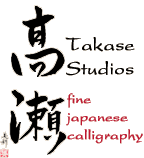Section 1
1 Tools
2 Lines
3 永 ei
4 本 hon
5 自 ji
6 由 yuu
Section 2
7 主 shu
8 月 tsuki
9 花 hana
10 岩 iwa
11 友 tomo
12 目 me
Section 3
13 耳 mimi
14 手 te
15 米 kome
16 国 kuni
17 光 hikari
18 空 sora
Section 4
19 見 ken
20 天地 tenchi
21 春風 harukaze
22 克己 kokki
23 洗心 senshin
24 喜 ki
Section 5
25 ア a カ ka
26 サ sa タ ta
27 ナ na ハ ha
28 マ ma ヤ ya
29 ラ ra ワ wa
30 濁点 dakuten
Ritchie & Kathy
Names
Welcome to Takase Shodokai
Section 1: Kaisho Basic
This is the first section of the Takase Shodokai Learn Japanese Calligraphy Series.
This section introduces Japanese Calligraphy using the kaisho (Block) font. Kaisho is probably the most commonly seen Japanese font today and is noted as being bold and powerful with precise and crisp lines.
By the end of this section the student will have a good understanding of the tools used in Japanese Calligraphy along with their usage and care. The student will also have a solid introduction to the basic strokes and lines that comprise the kaisho font.
In this first lesson we discuss the tools required for Japanese Calligraphy. We discuss what to look for when purchasing tools and their proper care. Finally we discuss their usage including how to hold the brush and how to prepare the ink.
In this lesson we concentrate on basic lines where we cover the three basic styles each of yokoga (horizontal lines), tatega (vertical lines) and tensetsu (compound lines).
Lesson 3 - 永 ei (Eternity)
This lesson focuses on the eight basic strokes of kaisho calligraphy using the kanji for Eternity which is ei in Japanese.
Ei (Eternity) is usually the first character taught as it includes all of the basic strokes which are yokoga, migibarai, hidarihane, hidaribarai, ten, migihane, tatega, and tategahane.
Lesson 4 - 本 hon (Book)
In this lesson we focus on the two harai strokes and on drawing yokoga (horizontal lines) which will cleanly bisect the tatega (vertical line).
Lesson 5 - 自 ji (Self)
In this lesson we focus on ten, tatega, yokoga, and tensetsu.
Lesson 6 - 由 yuu (Reason)
Finally we focus on the character yuu 由 concentrating again on the tatega and tensetsu. This character combined with ji 自 from the previous lesson gives us the word jiyuu 自由 meaning Freedom or Liberty.
Copyright © 2017 Takase Studios, LLC. All Rights Reserved.

